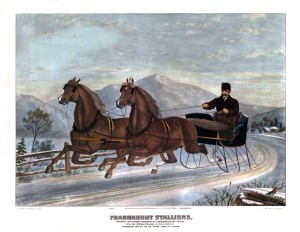It seems most appropriate that Scott Leighton is buried near his home town of Gray, Maine, yet only five miles from the Cumberland Fairgrounds where trotting horses are trained year round. Scott Leighton was born in 1847 in the town of Auburn, Maine, but grew up and attended school in Gray. According to his 1898 obituaries, Leighton was attracted to trotting horses as a teenager. By age seventeen he had saved enough money trading horses that he moved to Portland where he hoped to make a living as an artist. When things did not work out, he moved to Providence, Rhode Island and later to Boston, Massachusetts where he opened a studio before 1880.Leighton’s Boston studio became a meeting place for the leading horsemen of the day. With its four trotting tracks, Boston was an important hub for trotting on the East Coast. Most of the top trotting horses of his era came to tracks in Hartford, Providence and Boston. This gave Leighton an opportunity to sow his talent as a horse painter. One of his early paintings was of Camors by General Knox. About 1875 he painted a local favorite, Ben Morrill, sired by Winthrop Morrill. One of his most famous paintings was one of the locally owned trotting champion, Smuggler. Another popular painting was the “Fearnaught Stallions.” Fearnaught stock was introduced into Maine by E.L. Norcross who established the “Fearnaught Farm” in Manchester, Maine with B.S. Wright of Boston.Scott Leighton is probably best known for his some thirty paintings tat were used for lithographs published by Currier & Ives. These paintings included trotting champions Hopeful, Maud S, Smuggler, and St. Julien. Leighton also painted the French Coach stallion “Gemere” at Elmwood Stock Farm in Poland Springs. He also painted Young Rolfe, the sire of Champion trotter Nelson. He traveled to Cream Brook Farm in Stetson around 1882 to paint the stallions, Gideon and General Withers.Scott Leighton is a member of Harness Racing Hall of Fame in Goshen, New York and the New England Harness Writers’ Hall of Fame.









